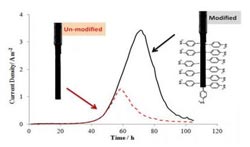Wiring microbes to conduct and produce electricity faster

This shows wiring microbes to conduct and produce electricity faster.<br><br>Credit: Amit Kumara<br>
Electron exchange is at the heart of all redox reactions occurring in the natural world, as well as in bioengineered systems: so called 'biolectrochemical systems'.
Practical applications of these systems include current generation, wastewater treatment, and biochemical and biofuel production. The microbial-electrode interface is a sum of complex physical-chemical and biological interactions permitting microbes to exchange electrons with solid electrodes to produce bioelectrochemical systems.
In these systems the microbes, compete, and self-select electrode materials for electron exchange capabilities. However, to date this selection is not well understood yet electricity or chemicals can be produced using various substrates, including wastewater or waste gases, depending upon operational settings, says Amit Kumar, who worked under the leadership of Dónal Leech at the National University of Ireland Galway in Ireland.
The Biomolecular Electronics Research Laboratory has been working on probing conditions for selection of electrodes by microbes for several years, and we have recently adopted an approach to tailor the chemistry of electrode surfaces which will help us better understand the selection mechanism says Amit Kumar and Dónal Leech. Our first result shows that surfaces modified with nitrogen-containing amines result in higher and more rapid production of current, compared to those without this modification, when placed in microbial cultures.
Next on our researcher agenda is to elucidate the selection mechanism using a range of surface modifications and microbial cultures.
ADDITIONAL AUTHORS:
Amit Kumara&,b, Peter Ó Conghailea, Piet Lensb and Dónal Leecha
aSchool of Chemistry & Ryan Institute, National University of Ireland Galway, Ireland.
bDepartment of Environmental Engineering and Water Technology, UNESCO-IHE, Delft, the Netherlands. Email amit.ugent@gmail.com
POPULAR TITLE:
Wiring microbes to conduct and produce electricity faster
The work was performed at the Biomolecular Electronics Research Laboratory (National University of Ireland, Galway).
Who did the work: Amit Kumar and co-authors
Funding source: European Commission, Marie Curie Program- Intra European Fellowship
Meeting: Gordon Research Conference, Applied & Environmental Microbiology
Exploring and Exploiting the Depths of the Microbial Biosphere
July, 2013, Mount Holyoke College, South Hadley, MA
Full study just published online in
RC Advances
Arylamine functionalization of carbon anodes for improved microbial electrocatalysis
Amit Kumar, Peter Ó Conghaile, Krishna Katuri, Piet Lens and Dónal Leech
RSC Adv., 2013, online at http://pubs.rsc.org/en/Content/ArticleLanding/2013/RA/c3ra42953a Or http://dx.doi.org/10.1039/c3ra42953a
Media Contact
More Information:
http://www.nuigalway.ie/All latest news from the category: Life Sciences and Chemistry
Articles and reports from the Life Sciences and chemistry area deal with applied and basic research into modern biology, chemistry and human medicine.
Valuable information can be found on a range of life sciences fields including bacteriology, biochemistry, bionics, bioinformatics, biophysics, biotechnology, genetics, geobotany, human biology, marine biology, microbiology, molecular biology, cellular biology, zoology, bioinorganic chemistry, microchemistry and environmental chemistry.
Newest articles

An Endless Loop: How Some Bacteria Evolve Along With the Seasons
The longest natural metagenome time series ever collected, with microbes, reveals a startling evolutionary pattern on repeat. A Microbial “Groundhog Year” in Lake Mendota Like Bill Murray in the movie…

Witness Groundbreaking Research on Achilles Tendon Recovery
Achilles tendon injuries are common but challenging to monitor during recovery due to the limitations of current imaging techniques. Researchers, led by Associate Professor Zeng Nan from the International Graduate…

Why Prevention Is Better Than Cure—A Novel Approach to Infectious Disease Outbreaks
Researchers have come up with a new way to identify more infectious variants of viruses or bacteria that start spreading in humans – including those causing flu, COVID, whooping cough…



